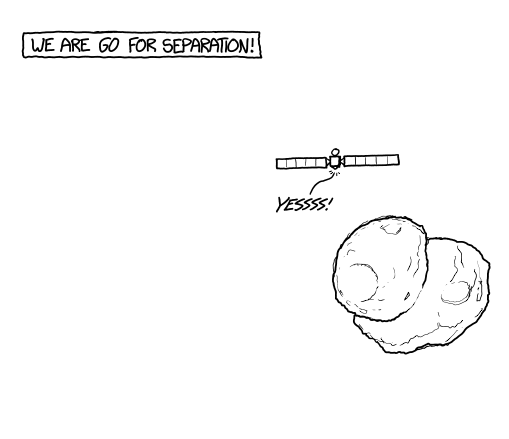Emily Lakdawalla • Nov 12, 2014
Philae update: "Go" for landing, despite apparent failure of cold-gas jet system [UPDATED]
Update 09:15 UTC: Just a few minutes ago, ESA confirmed that Philae has successfully separated from the orbiter. It will now take 7 hours for the spacecraft to descend to the comet. In a few hours, Rosetta should relay a "farewell" image taken by the lander.
Philae is "go" for landing. But there has been drama overnight. One of the steps to prepare for landing did not proceed as planned. A cold-gas jet -- a nitrogen thruster -- is supposed to fire upon landing in order to counteract any tendency for the lander to bounce off the surface. In order to prepare the thruster for use, a pin must puncture a wax seal over the gas reservoir. There were two redundant pins, and two efforts made to fire each of the two pins, but no pressure change happened after four attempts. Without the cold-gas system, Philae must rely on its two harpoons and ice screws to hold it to the surface. Whether that will be enough -- or whether the lander will bounce off before they can secure it to the surface -- remains to be seen.
There is an outside possibility that the problem is not with the pins but rather with the pressure transducers that are supposed to measure the pressure change, but mission manager Fred Jansen told me that wasn't very likely. This is not a unanimous opinion, however; apparently Paolo Ferri has told people that he thinks it's more likely a pressure transducer failure than a puncture failure. We'll see.
So why did they make the decision to go ahead and land? Because the likelihood of the pin-puncture succeeding after four failed attempts is less than 1%, Jansen told me. Delaying the landing wouldn't increase the likelihood of success (and might actually decrease it, because of the increasing activity of the comet), so they are "go" even without the cold-gas system.
You can watch the ESA media updates at their livestream; it's running live all day today. Separation will happen at 09:03 UT (01:03 PT), and landing is expected around 16:03 (08:03 PT).
I have been updating my timeline with the events as they have taken place, and I'll continue to do so all day.
And don't miss today's XKCD, which is an auto-refreshing, real-time cartoon of the comet adventure. (If you don't want to wait to see how the XKCD version of the story ends, go here.)
Support our core enterprises
Your support powers our mission to explore worlds, find life, and defend Earth. You make all the difference when you make a gift. Give today!
Donate

 Explore Worlds
Explore Worlds Find Life
Find Life Defend Earth
Defend Earth


